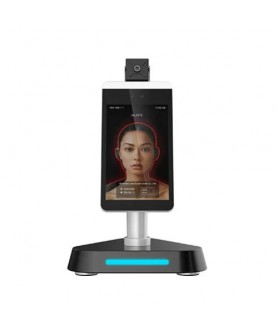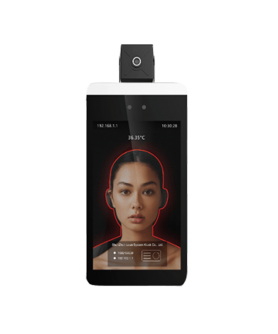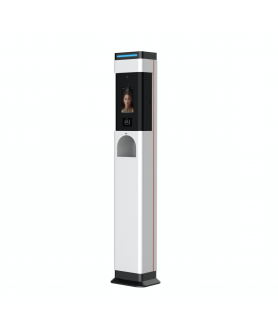ADA-compliant / NDAA-compliant / HIPAA-compliant
Face Recognition Systems
Smart Access Kiosk (comes w/Desktop Mount) / ADA Compliant
$799 Ex Tax: $799
A smart body temperature scanner with facial recognition and built-in notification system, the HealthGuard Technology Smart Access Kiosk provides safe..
Smart Access Kiosk (comes w/Wall Mount) / ADA Compliant
$749 Ex Tax: $749
The HealthGuard Technology Smart Access Kiosk is a body temperature reader with face recognition. It features a multi-use mounting system with desk st..
Smart Access Kiosk with 2-Foot Stand / ADA Compliant
$899 Ex Tax: $899
The Smart Access Kiosk with a 2-foot Stand is a body temperature scanner with face recognition. It offers quick and accurate temperature readings to s..
Smart Access Kiosk with 4-Foot Stand / ADA Compliant
$899 Ex Tax: $899
The HealthGuard Technology Smart Access Kiosk is engineered to scan body temperature, identify an individual’s face, and allow/disallow entry to emplo..
Smart Sanitizing Hub / ADA Compliant
$999 Ex Tax: $999
The Healthguard Technology Smart Sanitizing Hub is an automatic hand sanitizer dispenser with face recognition and thermal scan. It offers temperature..
In today’s world, where many health risks are at play, technology can do a lot to keep us safe. Many smart devices have proven to be effective in maintaining public security. One such device is a facial recognition security camera, which is used to recognize an individual’s face. It uses biometrics to identify facial features from an image or video. The system then analyzes and compares the information with a data bank of other faces to detect a match.
Typically, a facial recognition security system is seen as access control and is associated with other biometrics like eye iris or fingerprints recognition systems. Obviously, the accuracy of iris recognition or fingerprint recognition as biometric technology is higher than a facial recognition accuracy. However, face recognition products are widely adopted thanks to their non-invasive, contactless, quick, and accurate screening.
On top of that, today's market is offering facial scanners enabled with thermal scans. They are invaluable devices during this pandemic because they monitor temperatures along with allowing/denying entry based on a person’s health condition. All in all, face recognition technology is widely used for various purposes. In this post, our security experts will tell when and why we need security cameras with facial recognition. Keep reading to get to know their basic operation principles, the benefits of using these current devices, and more useful facts.
How a facial recognition security camera works
People are good at recognizing faces; we all easily identify the faces of our friends, family members, and acquaintances. That's because we are familiar with their face landmarks - eyes, nose, lips, etc. A face recognition system works the same way, but on a large, algorithmic scale - where you see a face, the device sees data. In other words, facial recognition hardware is a biometric artificial intelligence that can identify an individual by analyzing facial texture and shape. All the data is stored in the data bank and can only be accessed by authorized personnel. Technologies may vary, but below you'll find basic principles of operation.
- An image of an individual's face is captured from the image or video; the face may appear alone or in the crowd.
- A facial recognition scanner reads the face geometry; key factors are the distance from forehead to chin, the distance between eyes, bridge of the nose, the contour of the chin, lips, ears, etc. Plus, it recognizes facial landmarks. In the end, the software acquires a facial signature.
- A determination is made. The facial signature becomes a mathematical formula; it's stored in the data bank and can be compared with other faces.
Note that face recognition products vary in their ability to distinguish individuals under challenging conditions, e.g., suboptimal angle of view, low-quality image resolution, poor lighting, etc. So, it's always better to choose high-quality devices that promise to work effectively and provide excellent results.
Characteristics
Nowadays, facial recognition technology is advancing and becoming more widespread. It has a long history and was previously only used for security purposes. But today facial scanners are suitable even for medical use. Why are these devices so popular? What are their characteristics? Let's find out!
- A face recognition device can identify a person from about 8m distance.
- Thanks to the unique algorithm that combines a machine learning method and deep face learning, the system will be exceptionally accurate and recognize a person even if he/she wears a surgical mask or glasses.
- A high-quality device will feature an analytics section (gender and age statistics, people counting, etc.).
- A facial scanner can be integrated into the company's existing security system. Plus, it's apps-compatible.
- Premium-quality equipment can automatically optimize the settings to enhance video images detectability.
- Face images that the scanner has detected are retained in the database, and they can be searched later.
- Particular faces can be designated beforehand to send instant notification as soon as they are detected.
- Facial recognition access control will prohibit unverified individuals from entering the restricted area.
- The best equipment is enabled with a thermal scan, which will check visitors' temperature. As we all know, continuous temperature monitoring is one of the present-day pandemic precautions.
In sum, face recognition products offer plenty of beneficial features. Everyone (homeowner, enterprisers, authorities) who invests in such a device will benefit due to its reliability and accuracy. The technology may be as simple as a face recognition door lock system or sophisticated enough to serve national security purposes. You can choose any of them based on your demands and budget.
Benefits of facial recognition systems enabled with a thermal scan
There are many types of facial scanners available on the market, the principles of their operation are similar. However, some of the systems offer unique features. An excellent example of such systems is thermal cameras, or facial recognition systems enabled with a thermal scan. Thermal facial scanners capture heat emitted by the human body, detect the head's shape, and ignore accessories like makeup, glasses, or hats. Unlike conventional facial scanners, thermal cameras are capable of identifying even in nighttime or low-light conditions. There is no need to use a flash or expose the camera's location so that it can be used discreetly.
The accuracy of such a device is higher than 95%, depending on the brand and manufacturer. As we touched on above, the facial recognition system enabled with a thermal scan can monitor an individual’s temperature. This is one of the features that distinguishes a thermal camera from a conventional one. It performs not only as a fast access facial recognition tool but also as a temperature monitoring tool. This device will add huge value to the entrances, checkpoints, and other places that see the most foot traffic. It won't be an exaggeration to say that thermal scanners help to stop the spread of COVID-19 since the first sign of this deadly virus is elevated temperature.
Today’s market offers lots of thermal scanner options. Public health experts and numerous business owners highly recommend smart kiosks and smart sanitizing hubs that provide fast access facial recognition and temperature monitoring.
Smart Kiosk
This facial recognition system is ideal to place at waiting areas, entrances, and checkpoints. The system can be customized to a company’s needs, and its height is easily adjustable (2, 3.5, or 4.5 feet tall). The thermometer is designed to distinguish individuals, check temperatures, capture images, and send alerts to personnel if a high temperature is detected. The smart kiosk can perform as a quick, accurate employee-tracking tool, streamlining workers’ flow during shift changes.
Smart Sanitizing Hub
This stationary equipment is perfect for various organizations and offices. It's not only capable of recognizing faces but also catches the body temperature and notifies the thermographer if an individual has fever-like symptoms. This station features a built-in hand-sanitizing tool so that employees or visitors can clean their hands while being monitored for higher temperatures. Using this device will minimize the chances of infection to zero.
Use Cases
Facial recognition systems may be used for a multitude of applications! Here are several examples of their typical use:
Security: a biometric face recognition system helps to secure employees and visitors in companies and public places. It's capable of detecting criminals, missing people, exploited children, etc. Such equipment always supports and accelerates investigations.
- Governments: facial recognition systems help to identify individuals who overstay their visas.
- Face ID technology: it allows users to unlock their phones with the help of their face signature.
- Social media: facial recognition tools help to tag people in photos.
- Marketing: such systems help to identify age, gender, ethnicity, and target specific audiences.
- Biometric face recognition systems improve human-computer interaction.
- Healthcare: thanks to face analysis provided by facial recognition devices, now it's possible to detect some genetic diseases, accurately track patient's use of medicines, etc.
- Company security: facial recognition systems allow/deny entry to buildings, offices, or restricted areas.
As for facial recognition systems enabled with thermal scan, they have proven to be an effective method of combating COVID-19. Business owners can install them at checkpoints, entrances, etc., as an employee-tracking tool. Such a device will only permit entry to verified individuals. It promises to keep potentially infected individuals at home. How? The system checks the person’s temperature, and if they are feverish, they will be denied entry.
Smart kiosks and smart sanitizing hubs feature instant notifications—the systems alert personnel as soon as an individual with fever-like symptoms is detected. These devices are perfect for hospitals, schools, waiting areas, lobbies, public transport terminals, and any other high traffic area.
Facial scanners with temperature controls have been vital during this public health crisis. Although biometric facial recognition systems can be pricy, they’re worth every cent to keep employees and customers safe as we adjust to this new normal. These systems offer accurate monitoring and minimize chances of cross-contamination in public spaces.
Cost
Facial recognition system costs vary greatly and can cost as much as $30,000. The good new is that it’s possible to find less expensive equipment without compromising the quality. For example, a high-quality smart sanitizing hub with facial recognition features costs about $3,200, while the smart kiosk is about $2,400. While it’s still a substantial investment, especially for small businesses, it’ll definitely worthwhile so you can create a safe environment for your employees, partners, and guests with the best, reliable technology.








